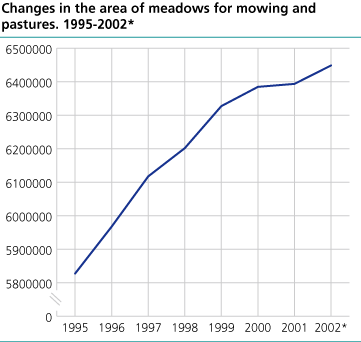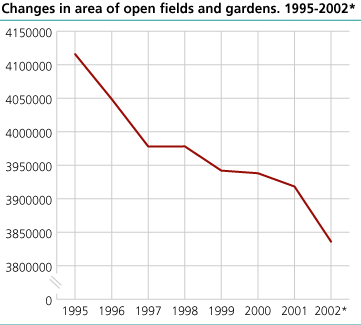Content
Published:
This is an archived release.
Less grain - more meadow
The area of meadows for mowing and pastures has increased in the period 2000 to 2002, while the area of grain has decreased. The total agricultural area was 10.3 million decares in 2002.
The area of meadows for mowing and pastures is increasing, and was 6.45 million decares in 2002. The area of meadow represents 63 per cent or 6.45 million decares of the total agricultural area in use in 2002. The grain area was 3.2 million decares, corresponding to 31 per cent of the total. The figures are based on governmental grants, to agricultural production.
Both fully cultivated land and surface cultivated and pastureland has increased from 2000 to 2002. Surface cultivated and pasture land increased by 44 800 decares to 1.61 million decares, and area of fully cultivated land by 30 000 decares to 4.84 million decares.
Grain area reduced with 2 per cent in 2 years
The grain area of 3.2 million decares in 2002 is 2 per cent less than the grain area in 2000. The area of oil seeds, which can be grown as an alternative to grain, increased in the same period from 57 000 to 108 900 decares. Barley represented 55 per cent of the total grain area, while oats and wheat represented 24 and 20 per cent respectively. A total of 18 400 holdings grew grain and oil seeds in 2002.
More beef cows, fewer dairy cows
The number of cows decreased from 342 100 in 2000 to 328 500 in 2002. The number of beef cows is rising, while the number of dairy cows is decreasing. It was about 48 100 beef cows in 2002, an increase by 3 700 from 2000. The number of dairy cows has in the same period decreased with 6 per cent to 280 400. Farms with cows fell by 2 500 to 22 700. The number of small herds is steadily decreasing, while particularly herds of 20 cows or more are increasing. The average holding with cow had 14.5 cows in 2002, as compared with 13.6 in 2000.
Tables:
- Table 1 Agricultural area, by use. 1995-2002*
- Table 2 Agricultural area, by county and use. 2002*
- Table 3 Domestic animals. 1995-2002*
- Table 4 Domestic animals, by county. 2002*
- Table 5 Holdings, by area used for grain and oil seeds. 1995-2002*
- Table 6 Holdings with cows, by size of herd. 1995-2002*
Contact
-
Statistics Norway's Information Centre
E-mail: informasjon@ssb.no
tel.: (+47) 21 09 46 42


